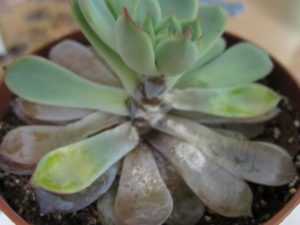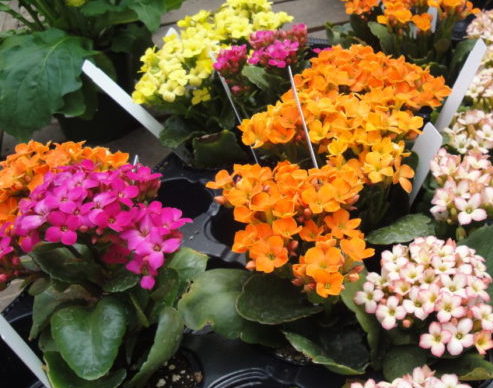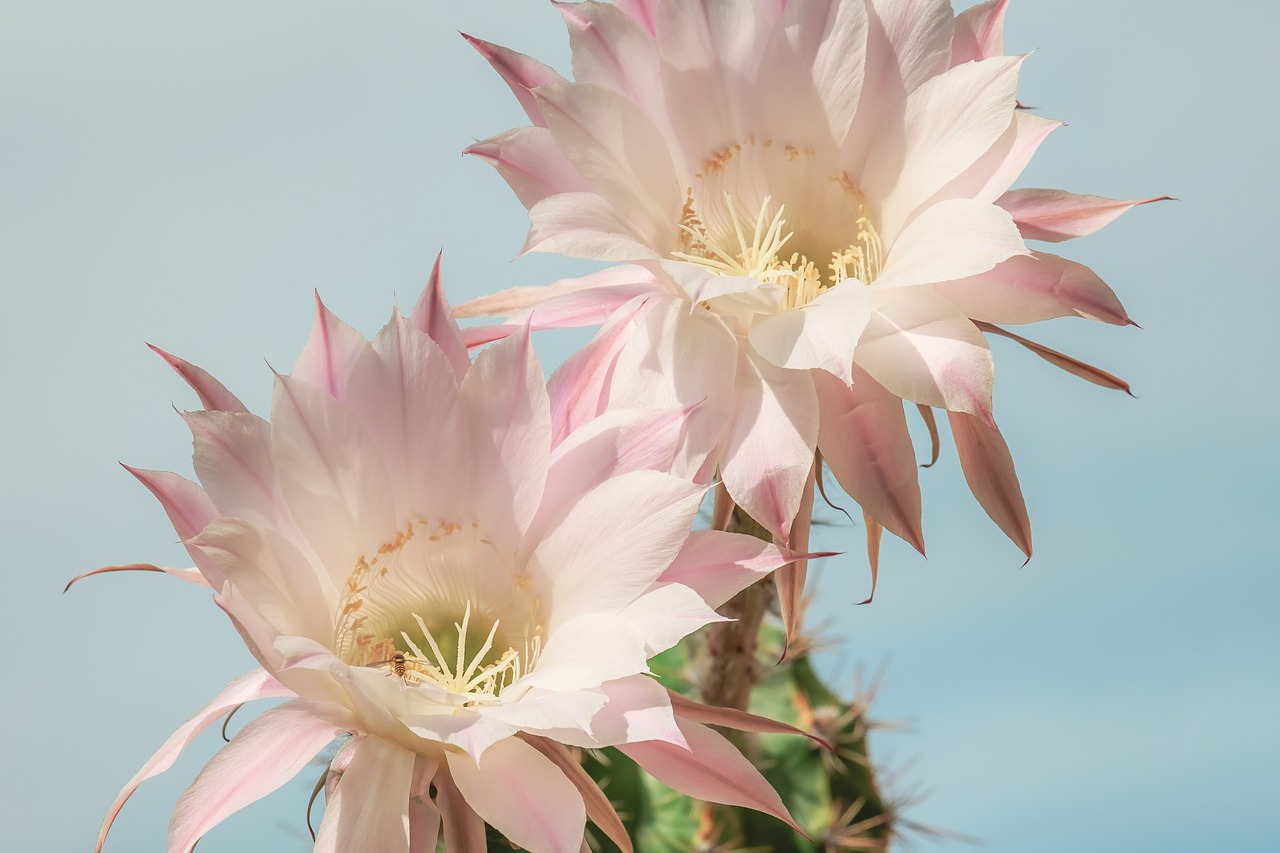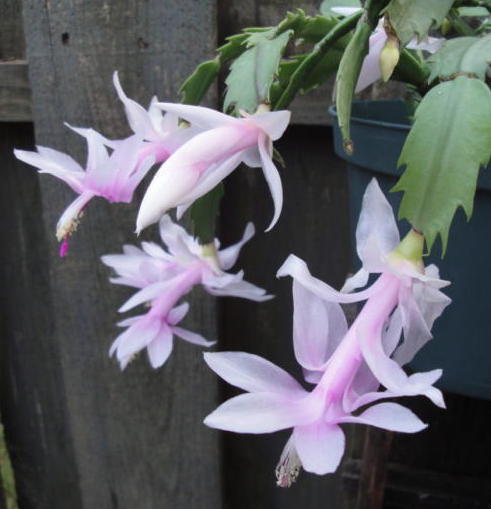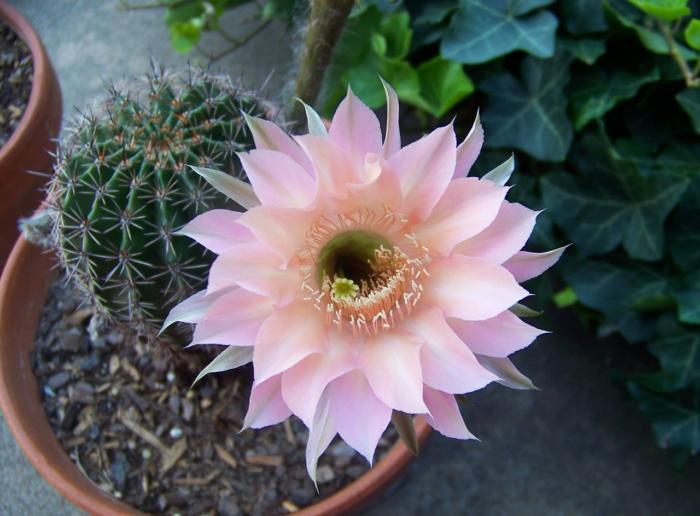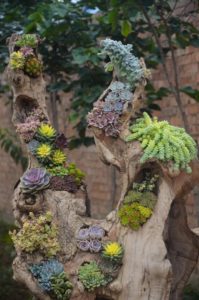Page 2
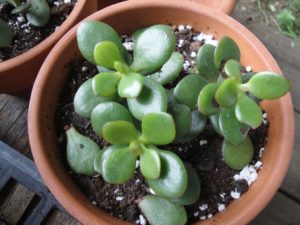
Miniature jade plants propagated from cuttings.
Propagation of Succulents
One trait that has made succulents so successful in their native environments is the ability to propagate themselves by various means. This is where their water storage capability provides an advantage.
Parts of plants—leaves, small pieces of stems, whole branches—broken off by animals stay viable until they root into the ground. Broken stems of non-succulent plants requiring more water, such as coleus and impatiens, usually dry up and die before they can root in the garden.
In the horticultural trade, growers have their favorite methods, but most species of succulents can be propagated in a few ways. While single leaves yield many more plants identical to the parent, those plants also can be grown from stem cuttings or from seeds.
Rather than shielding them from direct sunlight, give propagations a few hours of morning sun indoors until they root. They’ll respond faster and experience less rot than those grown in lower light. Plants propagated outdoors in the summer might be able to withstand some direct sun, but move to light or dappled shade if the cuttings exhibit signs of stress (patches of burned foliage, brown edges, reddening).
Keep the cuttings in the 70’s to the low 80’s F while they’re rooting.
Rooting Cuttings
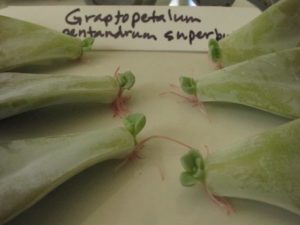
Leaf cuttings of Graptopetalum pentandrum ‘Superbum’.
Prepare a few small clay pots to root the cuttings. Cover the drainage hole with a bit of polyester fiberfill (from a craft shop). This synthetic material prevents soil from eroding through the hole while letting excess water escape.
Fill the pots with dry succulent soil or dry potting soil amended with coarse sand, perlite, pine fines, or horticultural grit for faster drainage.
I rooted a few stems of this miniature jade plant (Crassula ovata ‘Minima’, photo, top) in a 4″ clay pot. A few leaves on top of the soil also will root and grow plantlets.
Stem Cuttings
Use healthy cuttings 1-3″ long and insert one or a few in each pot. Remove leaves that will end up under the soil. Place the pots in gentle morning sun (direct sun, not just light). Keep the soil dry for a few days, then lightly mist the cuttings.
When they show new growth, water thoroughly, but let the soil dry between waterings. Never let the pots sit in a saucer of water for more than a few minutes.
Jade plants (Crassula), burrow’s tail (Sedum), Rhipsalis, Kalanchoe, Portulacaria, and stretched-out echeverias are a few that can be propagated from stem cuttings.
Leaf Cuttings
Many succulents can be propagated from leaf cuttings (photo, above). Simply lay them on the surface of dry succulent soil. If they start withering, lightly mist every couple of days, in the morning, until you see roots emerging at the petiole end of the leaf. Keeping them too wet will rot them. Pot them up, perhaps a few leaves in a 3″ clay pot, and they’ll soon grow new stems and leaves. Increase the amount of sunlight when they begin to grow.
Thick leaves, such as those in the photo, can be started on a dish and then potted when roots grow. These graptopetalums have already grown little plants on the ends. I potted them with only the roots in the soil, with the plantlet above soil level. Don’t bury the tiny plantlets, but simply lay them on the surface of the soil. They’ll know what to do.
Plants that can be propagated from leaf cuttings include Echeveria, Kalanchoe, Gasteria, and Haworthia.
Division
Plants developing multiple crowns in a pot can be divided. Pups growing alongside the main stem of Aloe barbadensis (formerly Aloe vera) can be separated from the parent plant and grown on independently. Make sure the young plantlet has some roots attached.
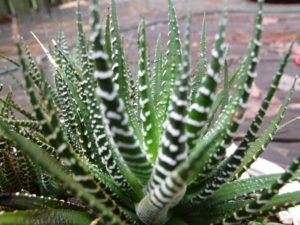
Haworthia fasciata.
Haworthia and Gasteria are easily divided. Remove them from their pots and use a paring knife to separate the clumps. Even without roots, a healthy crown will grow roots, but be careful not to keep the medium too moist. Dry soil is best for the first few days, while the wound is sealing over.
Species that creep along the soil also can be divided. Sedums, string of pearls (Senecio rowleyanus), string of hearts (Ceropegia), clumping species of crassula, and many others can be divided.
Seed
Succulents can be started from seeds, which is how they often multiply in nature. Seed mixtures are available, as well as individual species. Cactus and succulent societies might provide better access to the plants you’re looking for.
Root Rot And Insects
Root or Stem Rot
It’s a good idea to periodically examine your plants for signs of root rot. When this happens, the soil seems to stay moist for a long period of time, and leaves look wrinkled, watery, pale, or purplish in color. They might drop most of their leaves.
During the growing season, determine whether your plants should be downsized to smaller pots before that week of heavy rain initiates problems. They have better chances of surviving summer rains when grown in small pots. Most succulents have limited root systems and thrive when potbound.
Check the health of the root system by removing the plant from the pot. Trim off dead roots, and remove loose soil. Repot, using fresh dry soil, into a pot just big enough to fit the root system. Don’t reuse the old soil, but compost it or simply discard it under the shrubs.
A plant that has stem rot cannot be saved, unless the tip of the stem shows no rot or damage. This plant I had just purchased (photo, above) was left out in the rain—my mistake—but I was able to root the stem tip. The soil was mostly peat moss and didn’t drain well in the 4″ plastic pot.
Insects and Mites
Houseplants might live for years without sustaining insect damage. Now and then, though, insects show up and mar that perfect foliage you’ve enjoyed for so long.
Treat insect infestations with horticultural oil (not dormant oil). Commonly found pests include mealybugs, spider mites, thrips, scale, and aphids.
Nematodes can be a problem in sandy soils, and beetles sometimes attack succulents. Ask your local cooperative extension specialist about a particular strain of Bacillus thuringiensis that controls nematodes.
Mealybugs, resembling white cottony masses, are especially attracted to succulents. When spraying for these insects, use a strong stream of solution—not a fine mist—in order to get the insecticide to the insect below the protective cottony layer.
Complete coverage is necessary to kill pests on contact. Horticultural oil is safe to use, but it will make surfaces slippery.
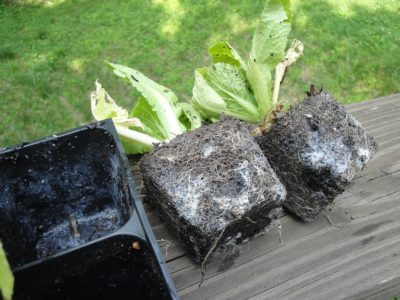
Root insects on Chinese cabbage. The white dusty material on the roots and inside the pot is diagnostic.
Some species of aphids and mealybugs feed on roots in the soil. These insects are especially difficult to notice and to control. Using a magnifying glass, you might spot tiny white or pale yellow insects crawling in the soil.
Unpot and inspect a plant that is in decline for no discernible reason. Ants congregating around plants might be an indication that insects are present. Ants feed on the pests’ sugary excrement. These pests drain the life out of your succulents’ roots even though no insects are visible above ground.
Systemic insecticides are the best option for these soil insects. Always read label instructions.
Flowers
- Colorful flowers of Kalanchoe.
- Long flowering stem on Echeveria ‘Topsy Turvy’.
- Pachyphytum oviferum, Moonstones.
Subjected to cool temperatures in the fall, many succulents bloom the following winter or spring. Others bloom in summer. Their flowers can range from white, yellow, or mauve, to vivid pink, orange, or red. The small Echeveria carnicolor has little bell-shaped flowers of almost neon pink, orange, and yellow—aptly named!
Some flowers are barely noticeable, and others can rise a couple of feet above the foliage. This is a huge group of plants, so there is great variability among the species. Cactus flowers are often stunning in shape and color (photos, below).
Pachyphytum oviferum, with chubby ghostly leaves, is one of my favorites for foliage, and blooms in the spring. Echeveria ‘Topsy Turvy’ has chalky blue leaves rolled down at the edges, and, as a bonus, sends up tall stalks of luminous orange flowers (photos above).
Kalanchoe blossfeldiana (photo, above left), a popular flowering succulent, is available year-round at garden centers. Its white, yellow, orange, pink, or red flowers are single or double in form. Kalanchoes are available in 2″ and 4″ pots; tuck them into horticultural arrangements for a spot of seasonal color.
- This cactus flower resembles orchid cactus (Epiphyllum oxypetalum).
- Christmas cactus.
- Beautiful cactus flower.
Time To Grow That Collection!
Here’s a fascinating method of displaying a colorful collection of succulents: plant them in an up-ended log (photo, above) or piece of driftwood! This kind of arrangement grows better on an outdoor patio or in a greenhouse. Be sure to provide drainage in each planting pocket.
Now it’s time to choose your plants. Succulents are incredibly diverse in color, shape, size, and texture. Tiny miniatures fit on a narrow windowsill, while others grow to several feet in height. Plant them in traditional clay pots or in sleek, modern pottery. Succulents have become very popular (again) and can be purchased from specialty growers at farmers’ markets, garden centers, and online.
Instead of using individual pots, you can gather a few plants together in a colorful dish garden that looks like a desert vignette. Look for interesting rocks, “found objects”, and gravel to add finishing touches. Use small or dwarf varieties to keep the garden attractive for a long period of time. Even in a shallow container, the soil dries quite slowly, especially when using gravel mulch.
Some garden centers sell colorful fast-growing succulents for containers or as outdoor plants for the garden. Most will not tolerate frost, so they need to move indoors in autumn. Whether you keep your succulents for decades or plant them in your garden as annuals, these plants offer endless fascination and enjoyment.
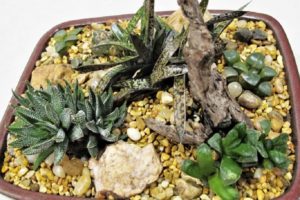
A shallow bonsai dish with gasterias and haworthias, driftwood, rocks, and gravel. Raccoons ate most of the haworthias, but I potted them up anyway. It took a few months to see any new growth on those plants (top corners).
Headings
Page 1: Speaking Of Succulents, What Is A Succulent?, Plenty Of Light For Succulents (When Light Is Insufficient), More Sun For Cacti, Light And Water, Pots, Potting Soil (Living Stones), Fertilizer, Outdoors For The Summer (And Back Inside In Autumn), Pruning Succulents
Page 2: Propagation Of Succulents (Rooting Cuttings, Stem Cuttings, Leaf Cuttings, Division, Seed), Root Rot And Insects (Root Or Stem Rot, Insects And Mites), Flowers, Time To Grow That Collection!
